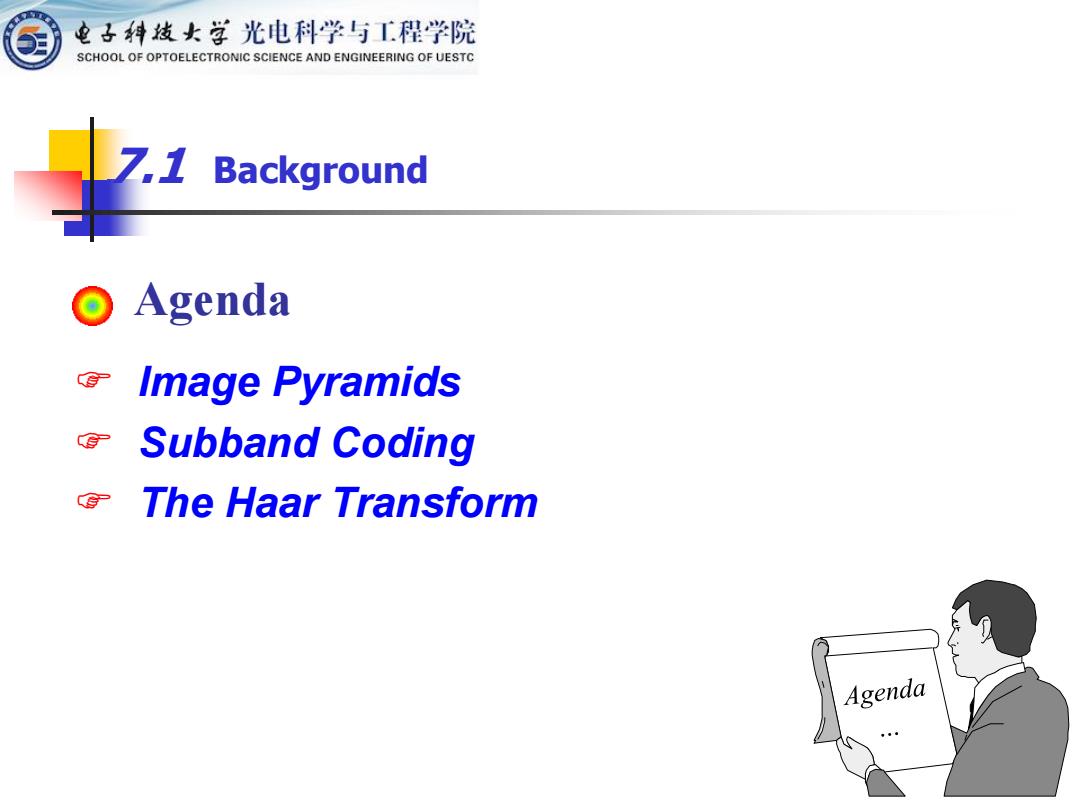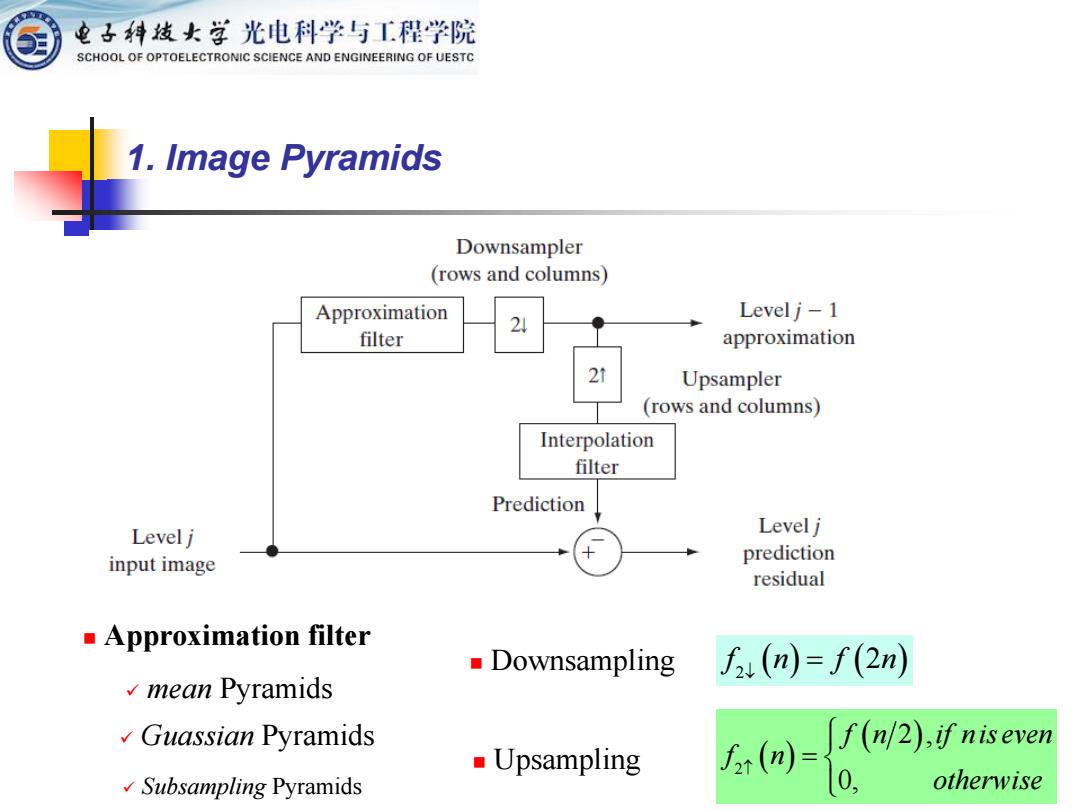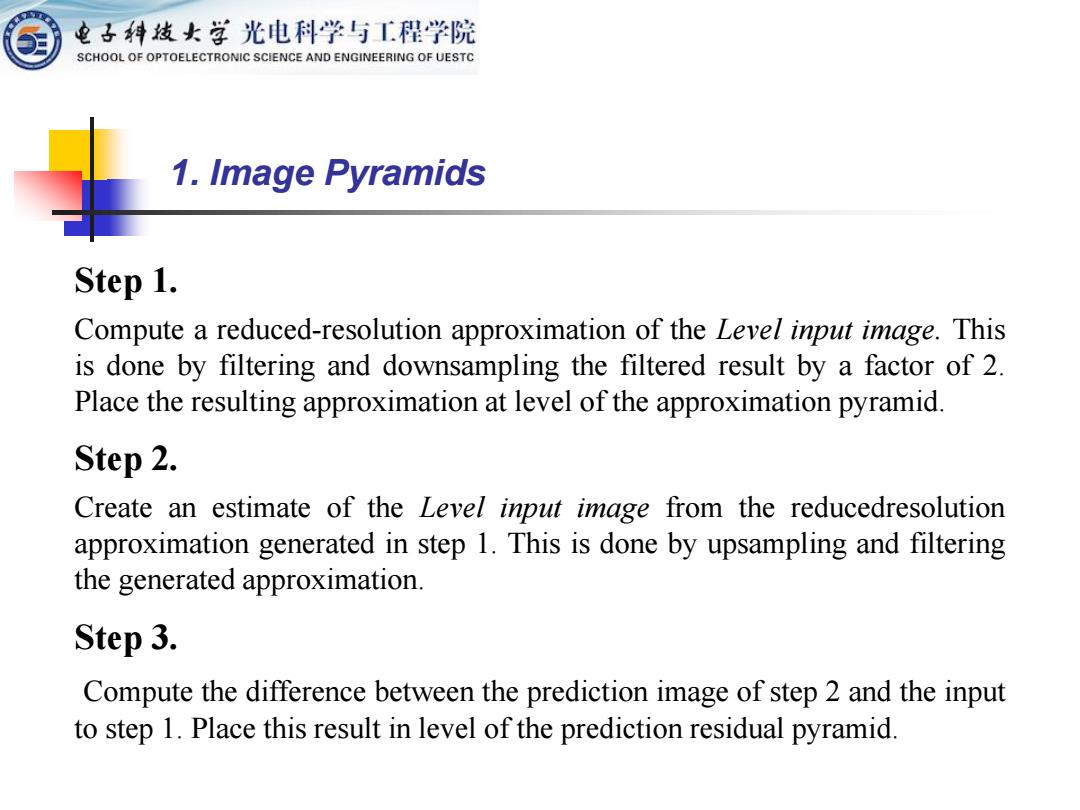
电子科枝女学光电科学与工程学院 SCHOOL OF OPTOELECTRONIC SCIENCE AND ENGINEERING OF UESTC 71 Background Agenda Image Pyramids Subband Coding g The Haar Transform Agenda
Image Pyramids Subband Coding The Haar Transform Agenda 7.1 Background

电子科线女学光电科学与工程学院 SCHOOL OF OPTOELECTRONIC SCIENCE AND ENGINEERING OF UESTC 1.Image Pyramids FIGURE 7.1 An image and its local histogram variations. Small sized or low in contrast objects: >Several resolutions needed to examined at high resolution. distinguished between different Large sized or high in contrast:examined objects. at a coarse view
1. Image Pyramids ⚫ Small sized or low in contrast objects: examined at high resolution. ⚫ Large sized or high in contrast: examined at a coarse view. ➢Several resolutions needed to distinguished between different objects

电子科线女学光电科学与工程学院 SCHOOL OF OPTOELECTRONIC SCIENCE AND ENGINEERING OF UESTC 1.Image Pyramids 1×1 Level 0(apex) 2×2 Level 1 4×4 Level2 ● ● N/2×N/2 LevelJ-1 、LevelJ(base) N×N ■Base level J=l0g2 N The total number of pixel in P+1 level *西可**可}小
2 J N = log( ) ( ) ( ) 2 2 1 2 1 1 1 4 1 ... 4 4 4 3 N N P + + + + 1. Image Pyramids ◼ Base level The total number of pixel in P+1 level

电子科枝女学光电科学与工程学院 SCHOOL OF OPTOELECTRONIC SCIENCE AND ENGINEERING OF UESTC 1.Image Pyramids Downsampler (rows and columns) Approximation Levelj-1 24 filter approximation 21 Upsampler (rows and columns) Interpolation filter Prediction Levelj Levelj input image prediction residual Approximation filter Downsampling f,(n)=f(2n) mean Pyramids Guassian Pyramids Upsampling 5,()=(/2),f niseven Subsampling Pyramids 0, otherwise
1. Image Pyramids ◼ Upsampling ( ) ( ) 2 2 , 0, f n if nis even f n otherwise = ◼ Downsampling ( ) ( ) 2 f n f n2 = ✓ mean Pyramids ✓ Guassian Pyramids ✓ Subsampling Pyramids ◼ Approximation filter

电子科枝女学光电科学与工程学院 SCHOOL OF OPTOELECTRONIC SCIENCE AND ENGINEERING OF UESTC 1.Image Pyramids Step 1. Compute a reduced-resolution approximation of the Level input image.This is done by filtering and downsampling the filtered result by a factor of 2. Place the resulting approximation at level of the approximation pyramid. Step 2. Create an estimate of the Level input image from the reducedresolution approximation generated in step 1.This is done by upsampling and filtering the generated approximation. Step 3. Compute the difference between the prediction image of step 2 and the input to step 1.Place this result in level of the prediction residual pyramid
1. Image Pyramids Step 1. Compute a reduced-resolution approximation of the Level input image. This is done by filtering and downsampling the filtered result by a factor of 2. Place the resulting approximation at level of the approximation pyramid. Step 2. Create an estimate of the Level input image from the reducedresolution approximation generated in step 1. This is done by upsampling and filtering the generated approximation. Step 3. Compute the difference between the prediction image of step 2 and the input to step 1. Place this result in level of the prediction residual pyramid